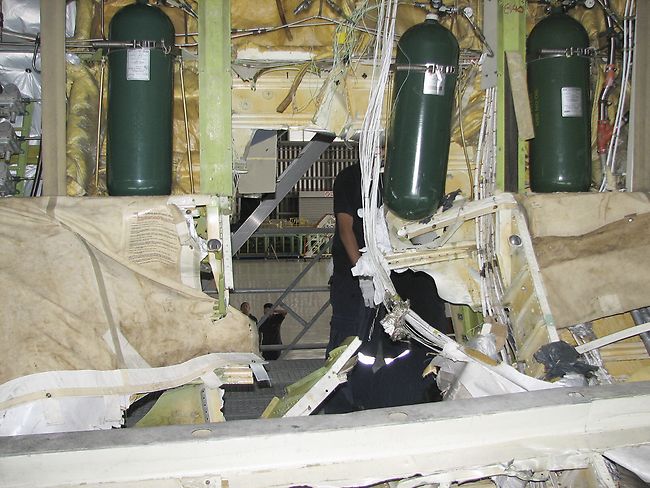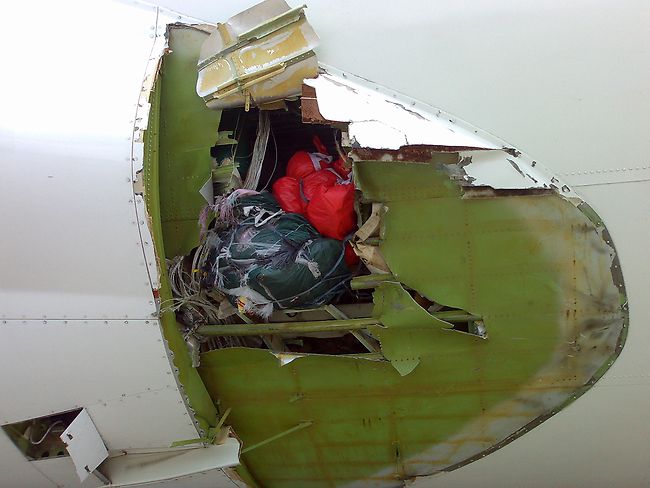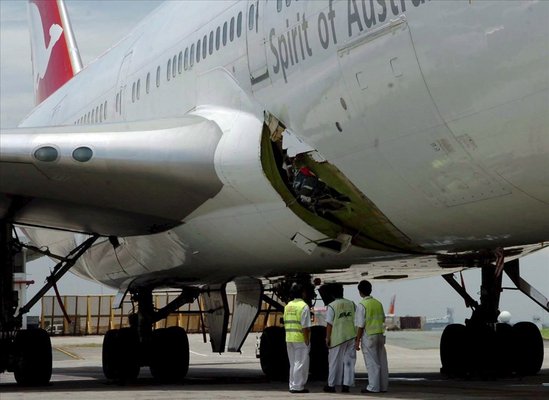| |
MH370 - Non-Speculative
(and based on Precedents and Reported Circumstance) |
| 1 |
Introduction Having watched CNN's program "the Vanishing",
a speculative, factual and interpretive review of MH370's fate, I am struck moreso by the
historical
facts that are not being considered - and the dearth of any real
attempts to explain quite explicable events. The logical "non-nefarious"
explanation for MH370 has been available and widely disseminated by me
in an opinion piece of April 2014 (1.). The reason why it's not popular
with Boeing or MAS will become evident. The first port of call whenever
there's a non-obvious aircraft accident is to review any precedents that
might be directly relevant. The most obvious one that could lead to
pilot incapacitation, and continued protracted flight of a partially
disabled aircraft, is the fire that destroyed the Egyptair 777 SU-GBP
"Nefertiti" on the tarmac at Cairo airport on 29 July 2011. It was a sudden oxygen flash-fire caused by
the electrically conductive helical anti-kink wire running internally
through the copilot's low
pressure oxygen hose. It shorted out (Report:
http://tinyurl.com/lxg34rl ). The
Egyptian copilot
necessarily vacated the cockpit immediately the fire broke out, under
Captain's orders to call the fire service. The captain, unsurprisingly
for an oxygen-fed fire, was unable to
have any effect at all on the blowtorch fire with a hand-held fire extinguisher
and vacated the flight-deck to supervise pax evacuation. The aircraft
was damaged beyond repair. Noteworthy was the fact that the oxygen
blowtorch effect at the copilot's side-console mounted regulator very
quickly ate its way through the side of the aircraft below the copilot's
side-window. No-one was injured. Very few bothered to extrapolate the
accident into just how intensely fraught it might prove to be in an airborne
circumstance. i.e an oxygen flash fire being lethal enough without even
considering the sudden depressurization of a holed fuselage and a lack
of pilot's oxygen - both pilots being reliant upon the same (now compromised
and unavailable) oxygen supply system - and the time of useful
consciousness without supplemental oxygen being measured in mere seconds
at above 30,000 feet altitude. Factor in the isolation of an
impenetrable locked cockpit door and the need for an instantaneous pilot
emergency descent
response to an aircraft depressurization, and you've created a crematorium up front
- and a morgue down the back. On the other side
of that cockpit door there would be little to convey the urgency of the
happenings in the cockpit - just a standard rubber jungle of dropdown
masks and the subtle incapacitation of hypoxia. After 15 minutes, if
the aircraft hasn't descended to a life-supportive altitude (18,000ft
and below), the dropdown masks' oxygen supplies would be exhausted and passengers
would die en masse. Flight attendants' consciousness would last much
longer, courtesy of their portable oxygen bottles. However it's not a
given that they would have been able to access the flight-deck.... or
would have tried, considering that their intercom was likely dead and
their responsibilities were primarily to the distressed and dying pax. |
| 2 |
Limitations and Characteristics of an Airborne Oxygen Flare Fire
Don’t be misled by
the SU-GBP imagery (in the Egyptian report) of the fire’s effect aft
of the flight-deck door. Because the firemen were concentrating upon
the evacuation of a full load of pax, the fire itself didn’t get
their full attention and it soon grabbed hold and was propagated aft
through the crown areas (similar to the SR-111 fire spread but in
the other direction due to the recirc fans being turned off by the
checklist[SR-111] – but rather through them being left ON). The
Egyptian firemen were not to know that it was an oxygen fire and
that the only way to fight it was to turn off the oxygen at source.
Aircon is
traditionally two packs to the larger volume of the cabin and only
half of one pack to the flight-deck. In other words, the flight-deck
airborne and in normal circumstances shares its recirc air-supply
with the cabin. On the ground the majority of APU pack/ or
ground-cart air would go to the cabin. But it matters not at all
because the flight-deck door would be open anyway, particularly as
the Egyptair captain soon sent the copilot aft and then attempted to
fight the fire himself with a handheld fire-ext, keeping the open
flight-deck door as his escape route.. So, to summarize, on the
ground there was nothing to stop the unfought fire spreading aft of
the open flight-deck door to the fwd galley….. either through the
door or via the crown-spaces above that door.
However airborne at
height, the fire would have been initially isolated to a
point-source, possibly giving the affected pilot time to remove
himself from his seat. But you cannot “fight” an oxygen fire – you
have to isolate the oxygen flow. Perhaps that’s a point worth making
(an auto-shut-off valve that’s motivated by volume outpour
excesses). However once the fire has quickly destroyed a few
square centimetres around its point source, like an acid eating
away, you then have a gush-dump of unimpeded outflow superimposed
upon an already oxygen-enriched flight-deck environment. That’s
essentially unsurvivable for anyone trapped that side of the
flight-deck door. So what's being said here is that once that fire
ignited, the pilots had around 30 to 90 seconds before their lungs
were seared (i.e. before they would’ve been cooked in the flash-over
of an oxygen dump as the last flow-limiter was burnt away). In that
period they wound in the autopilot’s turn-back and possibly
attempted to fight that fire. Quite a pointless gesture, probably
made through not realizing that it was an oxygen supported inferno.
But I’d guess that the point-source blowtorch would’ve already had
ample time to weaken the hull at that side-console location, being
assisted by the pressurization’s differential pressure, - and then
as the hull ruptured, the aural pressurization alarm sounded. If not
already masks ON at that point, the pressurization alarm gives rise
to just one fluid rote pilot reaction – masks ON, kill the autopilot
and dump the nose, accelerating to emergency descent speed (normally
+50 knots of IAS, at which point you deploy the speedbrakes and
close the power-levers). That’s the point at which the pilots
would’ve reached their time of useful consciousness without
supplementary oxygen – and also the point at which the cabin’s
rubber jungle of masks appeared. The fire’s been going for around 30
to 90 seconds and the pilots have now effectively expired. But
no-one aft of the locked flight-deck door would have a clue as to
what’s happened in the cockpit.
What happened to
the fire at the time of depressurization? The oxygen-enriched
atmosphere on the flight-deck would’ve instantly become the cold
oxygen-depleted air of the thin ambient atmosphere at 35,000ft. Fire
would’ve been totally quenched and any residual smoulder soon
dampened. Damage would be visually minimal but many plastic
switches, their surrounds, circuit breakers, keypads and screens
would’ve been affected by the flash-over, killing some systems.
Meanwhile back in the cabin, the flight attendants are doing their
drill, assuming that the pilots have it all under control, i.e. they
are seeing to the distressed passengers, confident that the steep
nose-down attitude is what should be expected. However once they
felt the g force of the pitch-up into a steep climb, they’d possibly
be wondering about that - but perhaps assuming that the rubber
jungle had been deployed by accident and that the cabin air would
again soon be breathable – and that the zoom back to their cruise
altitude was due to a pilot abandonment of the emergency descent.
But how would they now know that the air was breathable (or not)?
They are all on walk-around bottles and the pax are evidently only a
couple of minutes into their mask’s canister-supplied 10 minutes
worth. Quite unknown to them is the totality of what’s transpired
the other side of that door. They’d be awaiting an announcement.
Over the next 8 minutes the mask-wearing flight attendants have
little chance to co-consult with each other. Some may have had their
doubts that it was all going according to Hoyle, but were
individually afraid of being anything other than the calming F/A ,
each one individually attending to many distressed persons. At this
point the inevitable fate of all pax on board is to quietly
succumb. The F/A’s bottles, and any spares, would soon be being
shared with those pax who are evidently in trouble with their
respiration as their cannisters emptied. Many if not most Chinese
are smokers. My guess is that 20 minutes after the zoom climb, stall
and self-recovery, all aboard would’ve been dead or close to it. In
the interim, one or more Flight attendants may have attempted to
call the flight-deck but - with nil reply, - what were they to do or
assume? I’d suggest that they just got on with their duties as the
aircraft seemed to be now back in straight and level flight. Nobody
aft of the flight-deck door on MAS is taught to use their initiative
and question or query the pilots’ status. The assumption is always
to be that the pilots have everything under control.
In the last few
minutes of walk-round bottle life, who’s to know if some brave soul
unlocked the flight-deck door or tried to? If he/she had done so,
they’d have found something quite a bit less devastated than the
SU-GBP cockpit photo. There’d be some visual evidence of fire but
I’d suggest that their distraction (until the end of their oxygen
supply) would be an attempted resuscitation of one or both pilots.
The pilots would have masks on and show some burns but the main
evidence of their deaths would be hidden (seared lungs, eyes
tight-shut in their full-face masks and a hypoxic death).
If the Flight attendants found the pilots wearing their oxygen
masks, would they be likely to remove them and attempt to revive
them with a portable oxygen bottle? Most probably not. Imagine the average
F/A’s priorities? i.e. “We must resuscitate the pilots or we are
doomed”. But how would they ever go about it? Mouth to mouth?
Hardly.
Making a phone-call, even if they knew how to locate and
utilize the sat-phone and this was fire-unaffected? Hardly likely. Not sure whether the sat-phones are handset or headset
operated (or whether they are portable or compartment-stowed). If
they were on the pilot’s side consoles, they were likely cooked. If
any flight attendants made it into the flight-deck they'd have been
powerless to achieve anything. Even if radios were functional, the
microphones were now switched through to the oxygen facemasks. Headset
mikes, if any were evident, were probably switched inoperative.
You just cannot factor out perplexion, distraction and
panic in these time-locked scenarios that are outside a rear-end
crewmembers' experience.. It’s certainly a picture that
neither Boeing or MAS wants painted. |
| 3 |
Discussion (Boeing inAction) Following the Egyptian Report
upon the cause of the Nefertiti oxygen-fed fire at Cairo, Boeing issued a Service
Bulletin recommending an "inspect and repair as necessary" on the
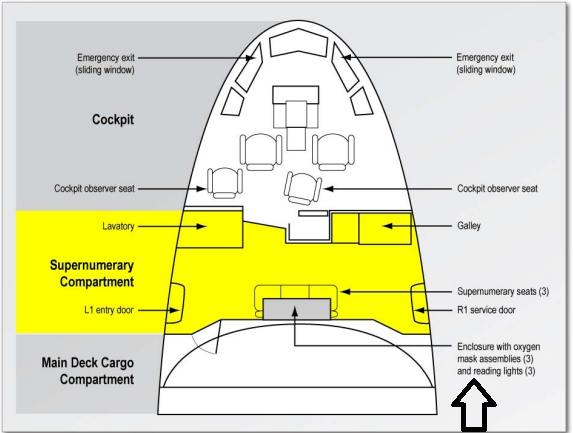 |
|
767 fire was in the Supernumerary
compartment |
777
pilot's low pressure oxygen hoses. The FAA backed this up with an FAA
Airworthiness Directive (mandatory only for US-certificated airplanes).
If MAS had elected to abide this Boeing/FAA guidance, they would have
signed off on that AD no later than the implementation date that was two
weeks prior to the disappearance of MH370. Did this happen? Prove it did
- or conversely, prove that it didn't. Don't expect MAS to divulge the
true facts on this lynch-pin question. It's not unusual for a
low-priority "fix" to be deferred by another country's airline, on local
authority, until the next major scheduled servicing. It's far more
common than anyone would think. Authority for this sort of delegated
deferment is often well down the line (at
deputy maint mgr level usually). To be fair, it can also be due to parts
availability or airframe requirements to meet schedules. But notwithstanding all that, it's
sufficient to note that Boeing and the FAA had been criticised in the
NTSB's 2009
report on another much earlier Jumbo jet loss (a 767 at San Francisco in 2008) in
which it had been found that the helical coil in the 3rd cockpit seat's
oxygen supply line had shorted out, causing the disastrous fire - see
next section.
This electrically conductive helical coil in the pilots vital flight
deck oxygen low pressure hoses has since proven to be commonplace
ubiquitous across many airliner models....even the 787. 767 Report: see
report: NTSB AAR-09/04/SUM at http://tinyurl.com/qjk6maa
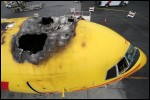 The 767 fire was in the regulator adjacent to the 3rd
supernumerary seat
The 767 fire was in the regulator adjacent to the 3rd
supernumerary seat |
|
| 4 |
Discussion (other similar accidents) 1.
28 Jun 2008. A Boeing 767 (reg: N799AX) burnt fiercely on the tarmac at
San Francisco following an electrically-initiated oxygen hose fire on
the flight deck. The fire quickly
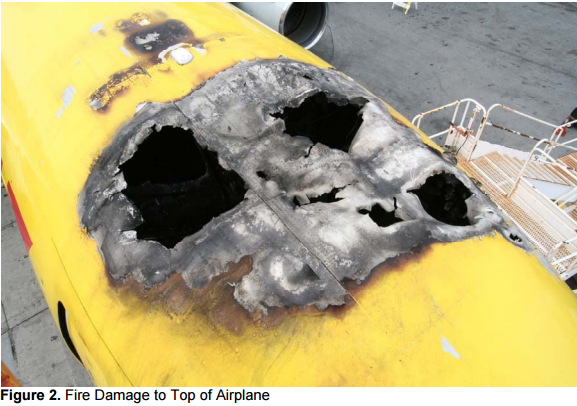 |
|
Oxygen Fire in 767
N799AX (aftermath) |
burnt through the fuselage above the
regulator (cockpit crown).
NTSB Report (PROBABLE CAUSE): "The National Transportation Safety Board determines
that the probable cause of this accident was the design of the
supplemental oxygen system hoses and the lack of positive separation
between electrical wiring and electrically conductive oxygen system
components. The lack of positive separation allowed a short circuit to
breach a combustible oxygen hose, release oxygen, and initiate a fire in
the supernumerary compartment that rapidly spread to other areas.
Contributing to this accident was the Federal Aviation Administration’s
failure to require the installation of nonconductive oxygen hoses after
the safety issue concerning conductive hoses was initially identified by
Boeing." (http://tinyurl.com/qbopru2
). The manufacturer of the PVC
flexible oxygen hoses installed a stainless steel coil spring in the
hoses, as shown in the report linked below, to prevent bends from
kinking and collapsing the hose
and thus disrupting the oxygen supply. The stainless steel helical coil was loosely
attached to the aluminum fittings at each hose end, making the hoses
electrically conductive.
http://aviation-safety.net/database/record.php?id=20080628-0
http://asndata.aviation-safety.net/reports/US/20080628-0_B762_N799AX.pdf
 Ground
Fire Aboard Cargo Airplane ABX Air Flight 1611 Boeing 767-200, N799AX
San Francisco, California June 28, 2008 (NTSB
AAR-09/04/SUM) Ground
Fire Aboard Cargo Airplane ABX Air Flight 1611 Boeing 767-200, N799AX
San Francisco, California June 28, 2008 (NTSB
AAR-09/04/SUM)
|
2. RAAF P3B Orion A9-300
imagery is at:
http://www.adf-gallery.com.au/gallery/Orion-A9-300a
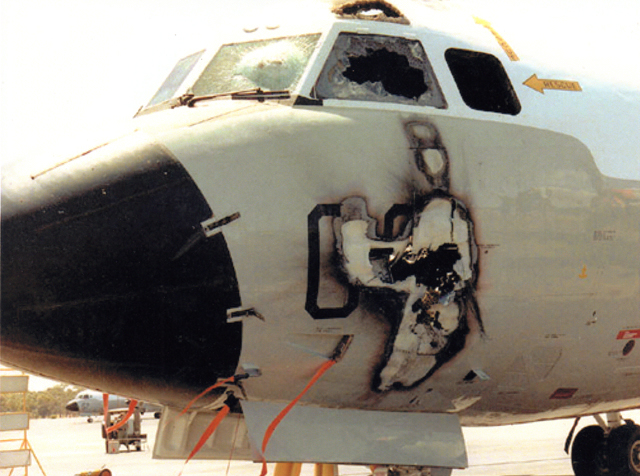 |
|
RAAF P3 Orion
of 92 Wing destroyed in an
Oxygen fire at RAAF Edinburgh
South Australia |
|
In this accident, 92 Wing maint personnel mistakenly disconnected an
oxygen line under pressure in the presence of a lubricant and metal
filings, resulting in
classic spontaneous combustion and an oxygen-fed flash fire that
destroyed the airplane on the ramp at RAAF Edinburgh South Australia.. (Defence
Report is at:
http://tinyurl.com/opyvmoz
)
Quote from the Report on A9-300:
"Under the prevailing conditions a jet of oxygen, at
a temperature high enough to blow the relief valve,
formed an "oxygen lance" which rapidly cut
through the cylinder. The remaining oxygen cylinder
pressure was sufficient to cause the cylinder to be
propelled through the side wall of the aircraft."
If this sounds familiar, you may recall that QANTAS
747
Flight QF30
lost an oxygen cylinder through the hull of a 747
cargo bay in similar circumstances (but airborne
approaching Manila) a
few years back.
(see
coverage and imagery below)
|
https://en.wikipedia.org/wiki/Qantas_Flight_30
Qantas Flight
30 (QF30, QFA30) was a Qantas Boeing
747-438, construction ... The
flight was interrupted when an oxygen
tank exploded causing
a fuselage ...
australianaviation.com.au/.../atsb-investigation-highlights-qf30-oxygen-b...
Nov 22, 2010 - ...
of the explosion of
an oxygen bottle on a Qantas Boeing
747-400 in ... any other related
instances of aviation oxygen
cylinder rupture
(civil or ...
-
www.atsb.gov.au/media/3154108/jan-feb11.pdf
Martin Dolan. Chief
Commissioner. The Australian
Aviation Saf.
The rupture of an
oxygen cylinder on
board a Qantas Boeing
747 was a unique event
and highly.
www.smh.com.au/.../valve-in-oxygen-cylinder-the-culprit-in-747-explosio...
Jul 29, 2008 - A
valve from an oxygen
cylinder blasted
a hole at least 20 centimetres
in diameter in the floor of the
passenger cabin of the Qantas 747
stricken ...
www.theaustralian.com.au/news/gallery-e6frg6n6-1225958326726?page...
Qantas flight
30 from London to Melbourne was
forced to land in Manila when an
oxygen cylinder exploded mid-air.
www.airsafe.com/plane-crash/qantas-flight-30-747-manila.htm
Area damaged by an exploding oxygen
cylinder in
a Qantas 747-400
... The second interim report
did not identify the cause of
the cylinder explosion,
but ...
www.flightpodcast.com/episode-6-john-bartels-qantas-qf30
Apr 17, 2011 - Qantas Flight
30 (QF30) was a Qantas Boeing
747-438 (construction ... The
flight was interrupted when an oxygen
tank exploded causing
a ...
www.jetspotter.com › ... ›
Aviation Forums › General
Discussion
Nov 17, 2009 - 2 posts - 2
authors
Qantas oxygen cylinder blast
mys.
The oxygen bottle's explosion ripped
a huge hole in the side of a Qantas Boeing
747. The oxygen
bottle's ...
www.abc.net.au/am/content/2008/s2315932.htm
Jul 28, 2008 - Aircraft
experts say its plausible that
an exploding oxygen
cylinder forced a QANTAS 747
to make an emergency landing in
Manila last Friday ...
|
An "Owed to Oxygen"
|
The National Transportation Safety Board (NTSB) performed
tests on PVC flexible oxygen hose assemblies that had been
removed from the accident airplane (767 - reg N799AX) and other ABX Air 767
airplanes to evaluate whether electrically energized hoses
could cause a fire. The test hoses were pressurized with oxygen,
and a 120-volt AC electrical current was passed through the
internal stainless steel coil spring by attaching electrical
conductors to the aluminum fittings at each end of the hose
assemblies, which resulted in the hoses becoming part of an
electrical circuit. Discrete tests at various energy levels
evaluated the hose assemblies’ response to becoming
electrically energized. (These energy levels were consistent
with those that were available on the airplane in the areas
where the oxygen system components were routed.) At low
energy levels, the heating of the internal spring by the
electrical current passing through it (known as resistance
heating) caused the PVC hose material to heat enough to
soften and allowed the oxygen pressure to rupture the hose.
At higher energy
levels, the internal spring could be heated until it became
an ignition energy source, causing the flexible oxygen hose
to ignite and sustain a fire. The time to failure
during the tests ranged from 6 to 180 seconds depending on
the amount of energy supplied to the internal spring. |
|
|
Page 8 of 767 Accident
Report (767 regn: N799AX) |
|
One common denominator identified in the Boeing accidents is that the oxygen
regulators and reading lights are in quite close juxtaposition. In the SU-GBP accident, the APU had just been started for
additional cabin cooling and ventilation when the flash-fire broke out.
The 767 report comments upon the fact that reading lights get very hot,
however it's more likely that the bus feeding the reading lights was
brought on-line by the APU start, providing the electrical power for the
short. i.e. Ground power units may not power systems busses identically.
However interestingly, the 2008 767 accident report also comments upon
the electrically conductive oxy-hose-internal anti-kink stiffener wire
and berates the FAA for not addressing this previously identified anomaly. Reading lights are
universally well-known for being "left on" - unnoticed in
daylight (and, as a result getting super-hot). In
the 767 accident the crew had just initiated their "mask's preflight
flow-check".
Airborne, when would a copilot reach for his mask in a
non-urgent situation? Answer: At cruising altitude, perhaps when the captain
announces that he's going on a toilet-break, leaving the copilot on his
lonesome on the other side of a locked door. This may have been the
scenario in MH370. Shortly after reaching top of climb, and having been
handed off to another ATC agency and settled in the cruise... this would
be the point at which most captains would elect to head aft on a toilet
break. |
| 5 |
| "...tests demonstrated the ignition and sustained
combustion of a pressurized PVC hose as a result of an
external ignition source. During these tests, the oxygen
hose did not ignite with a loud pop sound, but a loud
hissing sound was heard, and an intense fire resulted from
the burning of the PVC hose material. The NTSB concludes
that the pop and hissing sounds heard by the 767 flight crew,
immediately before the fire was discovered, were consistent
with the ignition of an oxygen hose by an internal rather
than external heat source.
The NTSB further concludes that
the design of the oxygen hose assembly allowed the internal
spring to become a source of ignition when it was
electrically energized, the PVC hose material to act as a
fuel, and the oxygen within the hose to promote burning."
|
|
Page 9 of 767 Accident
Report (Boeing 767 regn: N799AX) |
A Much Earlier Disregarded "Heads up"
on an Oxygen Flash Fire's airborne potentials
Rigorous Testing conducted for (and reported in) the 2009 dated
N799AX 767 accident report
were quite conclusive in determining the threat that an electrically
conductive internal stiffener wire coil presented to pilot's flight-deck
oxygen systems. The question becomes whether anything substantive was
ever done about rectifying this situation and assessing the airborne
threat scenario. Bearing in mind that many months
after MH370 went missing, Boeing and the FAA were still quietly
cleaning up this lethal anomaly across many (if not most) models in
the Boeing fleet types. (e.g. see the 787 Airworthiness Directive
with an effectivity date of 31 Dec 2014)..., so it would appear NOT.
Instead, the apparently mystic nature of MH370's
continued post-fire flight, loss of comms and transponder (and
seemingly inexplicable turns) was exploited to distract attention
from anything other than there having evidently been a nefarious
explanation (i.e. a terrorist hijacking or suicide plot). The FAA
and Boeing kept quiet on the subject of fire, but the FBI and
various national leaders lent their weighty opinion on third party
interference, "there being no other possible explanation". And of
course they were wrong, but the misdirection by vested interests
worked well and the favoured informal explanation remained... that
of nefarious intervention. The Boeing and MAS liability depends upon
MH370 never being found. However the distinctively different
phenomena of oxygen flash fire and hull rupture provides a very
plausible scenario and one that has ample precedent and unaddressed
anomalies. Another two aspects of 777 design will provide the answer
(see later, below) to the comms loss cause, the mystical "turns" and
the continued flight into the Southern Ocean.
|
| 6 |
Mentionable (other similar accidents)
Boeing 747 N571UP (from the
accident report)
"4. The uncontained cargo fire directly affected the independent
critical systems necessary for crew survivability. Heat from the fire
exposed the supplementary oxygen system to extreme thermal loading,
sufficient to generate a failure. This resulted in the oxygen supply
disruption leading to the abrupt failure of the Captain’s oxygen supply
and the incapacitation of the captain."
http://aviation-safety.net/database/record.php?id=20100903-0
|
| 7 |
In Passing.
There are potentially others (i.e. oxygen initiated fires) (e.g. 5V-TAG - a B707 on 21 Sep
2000 ) wherein the source of fire was never determined due to the
degree of disruption.
(B707 AP-AWZ on 26 Nov 1979) "A
second possibility is an electrical fire, but the rapid extension of the
fire was considered difficult to explain because of the electrical
circuit protection devices of the Boeing 707. Sabotage was considered as
another possibility, but no evidence of use of an incendiary device was
found."
Oxygen fires can be sneaky and difficult to uncover as
having been causative. The oxygen flash fire (as a source or trigger)
has become an "unmentionable" in reports where it cannot be positively
implicated. Wiring fires can often be proven by dint of beads left by
arcing, however oxygen-initiated fires are quite often misinterpreted as
oxygen-fuelled or -fed fires. Airborne oxygen flash fires are in fact
quite unique in that they are usually point-sourced, create a blowtorch
hull-rupturing at source (see SU-GBP and N799AX imagery) and can end
abruptly once the flow-source to the supply bottles is interdicted by
that fire. Any conflagrational follow-on from a cockpit fire at height
is quickly squelched by the hull-rupture and the oxygen rich atmosphere
on the closed flight-deck instantly giving way to a quite anoxic
depressurized atmosphere in which any residual smouldering is soon
extinguished. What we must consider is the transient effect of an oxygen
flash-fire upon the modern predominantly plastic push-button and plastic
display cockpit of the modern jetliner. How might these systems be affected
and would continued flight be possible? |
| 8 |
Plasticated Complications of the Modern Flight-deck
|
It is important to note that Boeing had received previous
reports of electrical energy causing leaks in oxygen hoses.
Specifically, Boeing had received a report from a 737
operator (the date of which is unknown) and from a 757
operator (in August 1997) indicating that cockpit flexible
oxygen hoses had developed leaks after an electrical current
had shorted and heated the internal coil spring, causing the
PVC hose material to melt and rupture. [Boeing’s and the
Federal Aviation Administration’s (FAA) response to these
reports are discussed in section 3.1.] |
|
N799AX Accident report page 10 |
During
the mid to late 80's there was a gradual digital-age transition from
metallic flip-and -toggle switches to the nowadays plastic push-button era on the modern
flight-deck. Logical and functional, yes... but not impervious to the searing
temperatures of a short duration oxygen flash fire. You could argue that
it is likely that the pilots, behind their secure cockpit door, would
have suffered seared lungs and eye damage and would have been unable to escape the fire
or able to get any succour from their oxygen masks - even if they'd been able to
don them. So would they have been able to do anything at all when (or
if) an oxygen flash fire had broken out? It may of course depend on
whether theMH370 captain was still seated or proceeding aft and thus
essentially clear. From the
timings and pilot actions cited in the SU-GBP and N799AX accident
reports, we are told that the SU-GBP captain attempted to fight the
fire. Might we assume that the MH370 captain or copilot may have had
time (prior to hull-rupture) to wind in a left-hand (shortest way)
autopilot turnback
towards Pulau Langkawi. We are further told of a 15 second delay
between aural indications of a malfunction and visible fire in the 767
incident. It might also be safely assumed that it would be instinctive,
even for an injured pilot, to disconnect the autopilot and "stuff the
nose down" into an emergency descent once the depressurization klaxon
sounded. However, having said that, that's approximately when all the
"happy ever after" potential outcomes would have ceased to exist. Due to injury or
passing out due to lack of oxygen, pilot input may have been limited to
disconnecting the autopilot and then forcibly lowering the pitch
attitude via his yoke. However, for this to have worked and eventually
achieve, despite the pilot's insensibility, a lower
life-supporting altitude, the
pilot would have also have had to trim decisively nose-down. Because of
being accustomed to auto-trim, many modern day pilots neglect, once in
extremis, to simultaneously use the manual trim-wheel (or manually
activated electric trim) in order to trim into a sustained
descent attitude. This was found to have been the case with the air-test
A320 lost
off Perpignan and in the Air France A330 crash (AF447). So what was the net effect
of the MH370 pilot passing out before accelerating to emergency
descent speed and retarding the power levers, extending the speedbrakes
or trimming nose-down? As his urgently held nose-down input on his yoke
ceased, there would have been a pitch-up into a stall due to the
out-of-trim state, a recovery and
then an eventual resumption of stable powered flight - all courtesy of the 777's
somewhat unique Active Flight Control System (AFCS).
But meanwhile, what of the aircraft systems and the much cited
puzzling loss of transponder, ACARS, comms etc? When an oxygen flash
fire erupts, it has a very short and finite life, particularly at
cruise-height when it is soon abruptly squelched by the loss of an
oxygen-enriched atmosphere - due to hull rupture. We could (fancifully)
couple this shortish duration fire to what the oil-rig worker saw. What
he reported has been widely poo-poo'd as unlikely, particularly in light
of MH370's continued flight. But it rings true for an oxygen flash-fire.
What might happen to the modern plastic flight deck when subjected to
such a suddenly super-heated environment - followed by the intense cold
of depressurization? Plastic switches may actuate or jam due to
dissimilar melting points in the plastics of switches and switch
surrounds, touch screens may actuate and lose function, other screens
may sag or melt, circuits may actuate, systems may fail or fail-safe,
circuit-breakers may trip. Some systems might fail temporarily and then
reset due to redundancy kick-in. The inherent vulnerability to a flash
fire of a plastic-switched and -screened cockpit is quite different to
the metal flip-and-toggle switched cockpits of yesteryear. Thus might
many systems have failed and explain why there was a coincident course
reversal and inerting of many comms related functions. The suddenness
and surprise of an oxygen flash fire easily explains why pilot reporting
would've been at least nil priority and at worst, impossible. This
unique fire scenario is nothing like the classic initiating "dark brown
smell" of the usual incipient "fire in the cockpit scenario".
It just happens and at most, from NTSB testing, will give a 5 second
loud hiss and a pop - as the hose internal fire erupts into the cockpit atmosphere.
|
| 9 |
The Continued Flight Conundrum
If the pilot had quickly
wound in a turnback heading upon the fire breaking out and the system
had achieved a standard rate LH turn through (about) 140 degrees (i.e. a
rough roll-out heading for the nearest available suitable airfield (Pulau
Langkawi or an airfield on the East Coast of the Malayan Peninsular south of Kuantan),
the aircraft would have rolled out Westbound just prior to any
blowtorch-induced hull rupture and depressurization alarm (i.e. it takes
around that long for an oxy blowtorch on the side-console to pierce the
hull). Upon then hearing the unique depressurization alarm, the
surviving pilot may have disconnected the autopilot and commenced his
instinctive entry into an emergency descent. As described above, once
the pilot(s) had succumbed to injury or hypoxia, the autopilot-off
9M-MRO would have pitched up, climbed a few thousand feet and stalled,
being thereafter in the hands of the Active Flight Control System (AFCS),
. This system is very very redundant and is unique in that it will
instantly counter a gust-induced wing-drop by immediately "picking up"
the dropped wing. The resultant heading constancy and lack of meander
left and right of course is quite remarkable for its longer term
stability. Likewise, the phugoid dampening abilities of the AFCS would
have rapidly recovered from any pitch-up stall and thereafter enabled a
pitch-trim dictated stable attitude in pitch. This pitch-trimmed
attitude would've been adequately supported by whatever high power (at
its initial cruise weight) had been set at level-off, prior to the fire.
As gross weight slowly reduced due to fuel burn-off, the aircraft would have
gradually continued a climb in a steady Thrust/Drag/Weight state of
equilibrium, considerably increasing its potential (air nautical miles
per pound) range to fuel
exhaustion.
But what of the later "mystical" turns prior to its lengthy
southbound final leg? The ITCZ easily explains that. The InterTropic
Convergence Zone is centered North of the Equator at that time of the
year and its prototypical thunderheads extend to well above 50,000 feet.
The pilotless MH370 would have blundered into any number of these and
been quickly spat out on different headings before the AFCS prevailed,
recovered from the upset and
restored a stable flight regime. Apparently the final "spit-out" was onto a
southerly heading. The higher MH370 climbed due to fuel burn-off and the
further south it tracked, the less likely it was to run into any further
thunderheads. Once south of the ITCZ and the Equator, the MH370 Ghost
Flight would have been well above and clear of thunderstorms vertically
and in eerily smooth air, with almost nil tracking meander. The only
asymmetry may have been due to its hull damage and a discharge of
pressurization air from that hull-rupture hole.
|
| 10 |
Fuel Exhaustion Aftermath As inferred above, the constant
climb technique of fuel burn-off permitting a continuous climb to an
ever greater altitude would have optimized MH370's achievable range
beyond that calculated by reference to the 777 manual - and moreover, by
up to 4% (which is a considerable additional mileage over a maximum
range to fuel exhaustion). This brings into question the southern
extents of the search areas. Once one engine had flamed out, MH370 may
have lost its directionality until such time as the second engine died
and then, with the RAT deployed and powering essential systems, the
residual unpowered pitch trim-state should have supported a low-speed
steady-state wings-level glide down to a more or less optimized attitude
for a wings-level splash-down on the ocean's surface. The flaperon found
on Reunion Island had damage along its trailing edge consistent with a
nose-high touchdown and was likely torn off by the starboard engine
pylon peeling off aft - as it took its gulping drink of seawater. The
diversion left or right of track induced by the fuel exhaustion
flame-out of the first engine is likely to have been less than 25 miles.
Fuel supply system equalization of modern jets tends to assure that a
double flameout fuel exhaustion event will occur within an overall
period of 5 to 8 minutes. If the "ditching" attitude was fairly benign
as described, it is likely that the MH370 hull and wings (and contents)
remained in place and intact.... explaining the lack of flotsam and
jetsam and bodies. Engines may have detached however and be located
quite separate from the eventual resting place of the drifting (and
highly flotational) hull. It's not unlikely that the two engines could
be located separately by the bottom-mappers and be dismissed from
further inspection as overboarded freight containers. |
| 11 |
Summary Coincident with the ATC hand-off to Vietnam's ATC
and immediately prior to 9M-MRO's reversal of course, there was an
abrupt cascade of events that overwhelmed the MH370 pilots - both
physically and with the power of surprise. Notwithstanding the pain and
the rapidly deteriorating environmentals, one of the pilots survived
long enough to wind in a course reversal towards Pulau Langkawi or
Kuantan - and then
entered an emergency descent once the hull was ruptured by the oxygen
blowtorch, causing the depressurization aural alarm to sound off. It's
entirely possible that the pilot donned his oxygen mask during the turn
or prior to commencing an emergency descent. Due to the very limited
time of useful consciousness above 30,000ft, the pilot would have passed
out due to the lack of available oxygen or the ingested smoke....
permitting the aircraft to zoom back up to height. This failure to
descend (to an altitude with breathable air) sealed the fate of all
aboard. It's unlikely that rear-end crew-members were aware of any
cockpit problem, and had only noted that pax oxy masks had dropped down.
Flight attendants would have assumed an emergency descent was then on
the cards and been reluctant to contact or distract the pilots. As the
aircraft entered a descent, their reassurance of a standard procedure
being underway would have been shattered by the subsequent climb.
Momentarily non-plussed by this, they'd have then suddenly been faced
with panic-stricken passengers who were passing out en masse within
around 10 minutes (due expiry of their limited emergency oxygen). Well
before MH370 had become "feet dry" above the Malay Peninsula, all aboard
would have expired. The ghost flight was then unpiloted with the
autopilot OFF and at the whimsy of the meteorological phenomena it was
now not able to avoid - in the seasonal geographic middle of the
Intertropic Convergence Zone (ITCZ). Having flown into a number of
CumuloNimbus cloud-tops (aka Thunderheads) and been spat out of the
turbulence on various headings, its last exit heading was southerly.
This took MH370 south of the Equator and thus well clear of the ITCZ's
latitudinally limited classic convective activity. Due to fuel burn-off
and smooth air, the aircraft would have climbed constantly until fuel
exhaustion. The collective mindset seems unable to comprehend the effect
of an oxygen flare fire upon a flight-deck full of plastic switches,
pushbuttons, screens and thermally activated circuit-breakers. They've
continued to disregard the oil-rig worker's sighting and indulged in
fanciful theories about unlawful interference.... based upon the easily
explained mystical mid-course heading changes. The solution (as
outlined) is actually so simple that it perversely leads one towards
speculation that the only nefarious conspiracy is amongst those who have
linked the adequate precedent accidents to MH370 - and who wish to
submerge that relationship. |
| 12 |
Conclusion All the various rehashes, including CNN's
"Vanish", delve into (and are replete with) finite but inconsequential
detail. Any broadbrush view of exactly what happened (and why) can
deduce a likely scenario and eliminate most (if not all) others. Some
additional clues, such as the oil-rig worker's sighting, can prove
useful when viewed against the likely explanation (and unique features)
of an oxygen flash-fire. The dead giveaways in most accidents are the
unique to type (or aircraft class) precedents. These stand out in the
MH370 saga as paramount concerns that were never held as real concerns
by the responsible parties (nor addressed properly), prior to MH370 (but
were "fixed" later with the benefit of secretive hindsights). So if one
was to venture that there'd been a cover-up you'd have to also ask:
"...but where's the proof?". More correctly, you could say that there
has been a policy of non-disclosure in knowledgeable quarters, a rush to
quietly fix the discrepancy, sage silence from the US regulator and a
simultaneous mischievous misdirection (by all of these authorities) to
be acquiescent in allowing the blame to be laid on nameless but
nefarious "third parties". |
| |
NTSB Recs and FAA
"Unacceptable Response" (below) |
| |
Follow-up / safety actions N799AX
NTSB issued 12 Safety
Recommendations
|
Issued: 08-JUL-2009 |
To: FAA |
A-09-043 |
|
Require operators to replace electrically conductive
combustible oxygen hoses with electrically
nonconductive hoses so that the internal hose spring
cannot be energized. (Open
- Acceptable Response) |
|
Issued: 08-JUL-2009 |
To: FAA |
A-09-044 |
|
Prohibit the use of electrically conductive
combustible oxygen hoses unless the conductivity of
the hose is an intentional and approved parameter in
the design. (Open - Acceptable Response) |
|
Issued: 08-JUL-2009 |
To: FAA |
A-09-045 |
|
Formalize the airworthiness directive process so
that, when an aircraft manufacturer or other source
identifies an airworthiness issue with an appliance,
coordination with the appliance manufacturer occurs
to ensure that the possible safety risks to all
products using the appliance are evaluated and
addressed. (Closed - Acceptable Action) |
|
Issued: 08-JUL-2009 |
To: FAA |
A-09-046 |
|
Require airplane manufacturers and modifiers to
provide positive separation between electrical
wiring and oxygen system tubing according to, at a
minimum, the guidance in Advisory Circular (AC)
43.13-1A, Acceptable Methods, Techniques, and
Practices Aircraft Inspection and Repair, and AC
65-15, Airframe and Powerplant Mechanics Airframe
Handbook. (Open - Acceptable Response) |
|
Issued: 08-JUL-2009 |
To: FAA |
A-09-047 |
|
Require airplane manufacturers and operators to
ensure that oxygen system tubing in proximity to
electrical wiring is made of, sleeved with, or
coated with nonconductive material or that the
tubing is otherwise physically isolated from
potential electrical sources. (Open - Acceptable
Response) |
|
Issued: 08-JUL-2009 |
To: FAA |
A-09-048 |
|
Develop minimum electrical grounding requirements
for oxygen system components and include these
requirements as part of the certification process
for new airplanes and approved supplemental type
certificate modifications to existing airplanes. (Open
- Unacceptable Response) |
|
Issued: 08-JUL-2009 |
To: FAA |
A-09-049 |
|
Once electrical grounding requirements for oxygen
system components are developed, as requested in
Safety Recommendation A-09-48, require airplane
operators and modifiers to inspect their airplanes
for compliance with these criteria and modify those
airplanes not in compliance accordingly. (Open
- Unacceptable Response) |
|
Issued: 08-JUL-2009 |
To: FAA |
A-09-050 |
|
Develop inspection criteria or service life limits
for flexible oxygen hoses to ensure that they meet
current certification and design standards. (Open -
Unacceptable Response) |
|
Issued: 08-JUL-2009 |
To: FAA |
A-09-051 |
|
Once inspection criteria or service life limits for
flexible oxygen hoses have been developed, as
requested in Safety Recommendation A-09-50, require
airplane operators to replace those hoses that do
not meet the inspection criteria or that exceed the
service life limits. (Open -
Unacceptable
Response) |
|
Issued: 08-JUL-2009 |
To: FAA |
A-09-052 |
|
Require transport-category airplane operators to (1)
perform a one-time inspection of all passenger
service unit reading lights installed on their
airplanes to ensure that they include rubber boots
or use other means to isolate the electrical parts
of the assembly and (2) include, in maintenance
manuals or other maintenance documentation,
information about the importance of this electrical
protection. (Closed -
Unacceptable
Action) |
|
Issued: 08-JUL-2009 |
To: FAA |
A-09-053 |
|
Require operators of transport-category cargo
airplanes to install smoke detectors in the
supernumerary or similar compartment of their
airplanes. (Open - Acceptable Response) |
|
Issued: 08-JUL-2009 |
To: ABX AIR |
A-09-054 |
|
Modify your continuing analysis and surveillance
program so that all identified chronic
discrepancies, such as those affecting the oxygen
system on the accident airplane, are effectively
resolved. (Closed - Acceptable Action) |
|
| |
That Oil-Rig Worker's Credibility
Ques: One thing: do you really think it is plausible the
'burning jet' seen by that oil-rig worker was MH370? I thought that its
trajectory was way outside the MAS plane's track?
Answer: On the question of the
oil-rig worker’s sighting feasibility, I haven’t done any analysis
in-depth on that. Once you read what’s below here, you may or may not
agree that it’s a case of “how long is a piece of string”?
However there is a
credible case to be made. Oxygen flare fires tend to be rather bright
against the night sky (particularly
if they are “undercast” (i.e. below an overcast of cloud layer or inside
cloud) i.e. think the appearance of sheet lightning being lightning seen
through an embracing cloud – it is that much more attention-getting). Also the flare tends to be
attention-getting (in comparison with an established fire of a
more-or-less static brilliance). Meteor sightings have been proven to
have been impossibly distant for visual sighting, yet arriving particles
as small as a tiny pebble tend to generate brilliant trails seen over
great distances. It’s a matter of varying contrast. You can clearly see
a rising moon over a huge distance whilst it’s still low on the horizon,
so I’d tend to favour the premise that something momentarily
incandescent will be viewable at a great range, mostly because of the
nature of its sudden emergence, as well as the distinct instantaneous
contrast on a dark night.
If you put a strobe
light alongside a light of the same number of “lumens”, at a great
distance (but separated laterally), whilst you would easily see the
strobe, you’d never notice the same intensity static light at the same
range, but in a slightly different direction. That’s why a strobe light
is used on aircraft nowadays - to enhance its visibility. It is so effective for visual acquisition
at great ranges and very low power. Its “pulse” waxes and wanes and thus
“commands” attention due to easy visual acquisition. The sudden pulse of
an oxygen flare fire outbreak, in an “empty visual field”, would be
viewable over hundreds of kms at night IMHO. i.e. the flare event itself
overcomes empty visual field myopia and provides a point of focus…. thus
greatly increasing visibility ranges.
See:
http://tinyurl.com/ngnaa6p
In case you’re not familiar with the phenomenon
of "empty visual field myopia"……
Empty field myopia (Empty
space myopia) - a condition in which the eyes, having nothing
specific within the available visual field upon which to focus, focus
automatically at a range of the order of a few metres ahead. Detection
of objects outside this restricted field of view is delayed and if an
object of interest does enter the restricted field of vision, the
determination of its size or range would be problematic.
Description
The normal function of the eye lens is to physically focus light from
the object on the retina. To do this, the eye must be stimulated by an
image. Empty field myopia manifests itself when the human eye is in a
passive state of focal point adjustment, i.e. when there is no image
(stimulus) for the eye to focus on, for example, when the eye is either
in complete darkness, or looking at a bright empty field. If the eye
lacks this stimulation, the lens is shifting to a resting state.
Resting State of Accommodation of the Human Eye
In this condition, the eye is usually focused at an intermediate point
(about 80 cm on average, although there are large variations up to few
metres), thus the healthy human eye becomes myopic.
In a nutshell: ..."an
aircraft that has a high degree of contrast against the background will
be easier to spot, while spotting one with low contrast at the same
distance may be hard and sometimes next to impossible." |

 The 767 fire was in the regulator adjacent to the 3rd
supernumerary seat
The 767 fire was in the regulator adjacent to the 3rd
supernumerary seat

